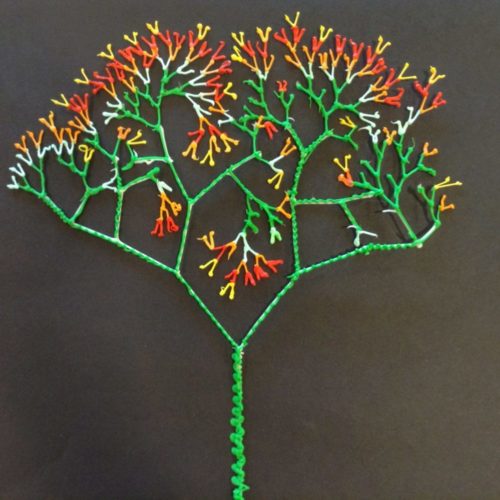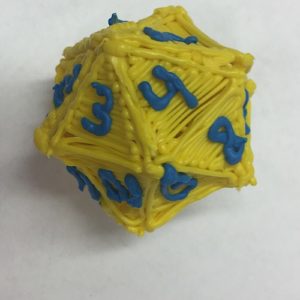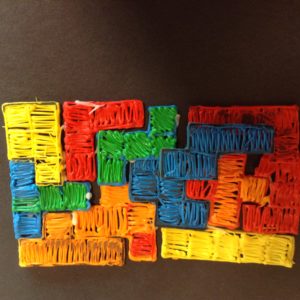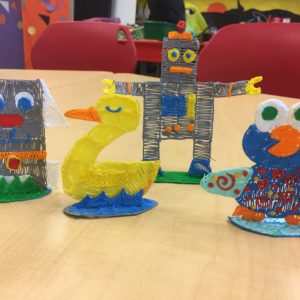MATH: Fractal Trees
In this FRACtivity, students will examine the natural ecology of tree branching, while exploring mathematical ratios and quotients to help interpret data. Students will work in pairs to create their own Doodled fractal tree as a tangible example of fractals. Within this activity, students will measure length and angles of branching, using rulers and protractors. For younger grade levels, more simplified mathematical concepts can be explored like patterns and symmetry.

Knowledge
Students have
practiced the included math concepts: ratios, quotients, measurement of lines and angles.
practiced the included math concepts: ratios, quotients, measurement of lines and angles.
Objectives
Students will
use tools, i.e., 3Doodler, protractor, and ruler, appropriately.
apply fractals to a real-world scenario in nature, i.e., tree branching.
repeat a pattern within tree branching.
measure lengths and angles of tree branching.
understand ratios and quotients as applied to tree branching.
use tools, i.e., 3Doodler, protractor, and ruler, appropriately.
apply fractals to a real-world scenario in nature, i.e., tree branching.
repeat a pattern within tree branching.
measure lengths and angles of tree branching.
understand ratios and quotients as applied to tree branching.
Materials
Students will need
3Doodler (1 per pair)
white construction paper (1 per pair)
pencil (2 per pair)
Fractal Tree Worksheet (1 per pair)
ruler with millimeters (1 per pair)
protractor (1 per pair)
calculator (1 per pair)
3Doodler (1 per pair)
white construction paper (1 per pair)
pencil (2 per pair)
Fractal Tree Worksheet (1 per pair)
ruler with millimeters (1 per pair)
protractor (1 per pair)
calculator (1 per pair)
Lesson Plan
Instructions
Step 1 - PREPARATION
Take a nature walk. Suggest that mathematics can be found in nature. Direct students to explore patterns in tree branches. Ask students to suggest other naturally occurring elements with similarly repeated branching. (Possible responses: rivers, cracks in ice or glass, blood vessels, lightning, neurons in the brain, creases on the palm of your hand.)
Step 2
Define a fractal: A repeating pattern. Branching fractals are one type of fractal found in trees. Project your tablet or computer screen for students to view and explore this link on fractal trees.
Step 3
Demonstrate how to draw a fractal tree stencil on your whiteboard or poster size paper.
a. Draw the trunk.
b. At the end of the trunk, split by some angle and draw two more branches.
c. Repeat at the end of each branch about 6-8 times.
Step 4
Model how to use a 3Doodler to doodle over the stencil. Do NOT peel the tree off of the paper.
Step 5
On stencil paper, label each branch segment and measure using a ruler. Example: AB
Record measurements on theFractal Tree Worksheet.
Step 6
Demonstrate how to compare the measurement of each branch segment using division and a calculator.
*Divide the length of branch AB (6 ml.) by branch BC (3 ml.) to get a quotient of 2 ml. Calculate the successive branches, two at a time, in this same manner and record the quotients on the Fractal Tree Worksheet.
Step 7
Demonstrate how to state the relationship between the length of branches as a ratio. Example: 6:3.
Step 8
Demonstrate how to measure the angle of each successive branching. Label each angle.
*See Appendix. Measure with a protractor and record on Fractal Tree Worksheet.
Step 9
Divide students into pairs. Instruct students to complete this same activity and record related observations on the Fractal Tree Worksheet.
Step 11
Circle to assist and assess.
Take a nature walk. Suggest that mathematics can be found in nature. Direct students to explore patterns in tree branches. Ask students to suggest other naturally occurring elements with similarly repeated branching. (Possible responses: rivers, cracks in ice or glass, blood vessels, lightning, neurons in the brain, creases on the palm of your hand.)
Define a fractal: A repeating pattern. Branching fractals are one type of fractal found in trees. Project your tablet or computer screen for students to view and explore this link on fractal trees.
Demonstrate how to draw a fractal tree stencil on your whiteboard or poster size paper.
a. Draw the trunk.
b. At the end of the trunk, split by some angle and draw two more branches.
c. Repeat at the end of each branch about 6-8 times.
Model how to use a 3Doodler to doodle over the stencil. Do NOT peel the tree off of the paper.
On stencil paper, label each branch segment and measure using a ruler. Example: AB
Record measurements on theFractal Tree Worksheet.
Demonstrate how to compare the measurement of each branch segment using division and a calculator.
*Divide the length of branch AB (6 ml.) by branch BC (3 ml.) to get a quotient of 2 ml. Calculate the successive branches, two at a time, in this same manner and record the quotients on the Fractal Tree Worksheet.
Demonstrate how to state the relationship between the length of branches as a ratio. Example: 6:3.
Demonstrate how to measure the angle of each successive branching. Label each angle.
*See Appendix. Measure with a protractor and record on Fractal Tree Worksheet.
Divide students into pairs. Instruct students to complete this same activity and record related observations on the Fractal Tree Worksheet.
Circle to assist and assess.
Wrap Up
Assessment
Possible Extensions
Resources
Vocabulary
acute angle - An angle that measures less than ninety degrees but more than zero degrees.
angle - the (rotational) space between two intersecting lines.
collaboration - to work jointly with others or together especially in an intellectual endeavor.
drawing - the art or technique of representing an object or outlining a figure, plan, or sketch by means of lines.
fractal - any of various extremely irregular curves or shapes for which any suitably chosen part is similar in shape to a given larger or smaller part when magnified or reduced to the same size.
line - an infinite extent which is one-dimensional and straight.
measurement - the act or process of measuring; a figure, extent, or amount obtained by measuring.
nature - the physical world and everything in it (such as plants, animals, mountains, oceans, stars, etc.) that is not made by people.
obtuse angles - Angles larger than 90 degrees.
pattern - an artistic, musical, literary, or mechanical design or form.
perpendicular - being at right angles to a given line or plane.
problem-solving - the process or act of finding a solution to a problem.
ratios - the relationship in quantity, amount, or size between two or more things.
repeat - renewed or recurring again and again.
symmetry - the correspondence in size, form, and arrangement of parts on opposite sides of a plane, line, or point; regularity of form or arrangement in terms of like, reciprocal, or corresponding parts.
tree - a woody perennial plant having a single usually elongate main stem generally with few or no branches on its lower part.
Educational Standards
Generate and analyze a pattern.
Students will construct a stencil and Doodle a tree as a fractal pattern, then analyze the relationship between the length of branch segments and angles.
Represent and interpret data.
Students will record their measurements as data and interpret their findings.
Geometric measurement: understand concepts of angle and measure angles.
Students will measure length and angles of tree branches.
Measure angles in whole-number degrees using a protractor. Sketch angles of specified measure.
Students will use a protractor to measure the branching angles on the Doodled fractal tree.
Draw points, lines, line segments, rays, angles (right, acute, obtuse), and perpendicular and parallel lines. Identify these in two-dimensional figures.
Students will draw a stencil of a fractal tree composed of line segments and angles.
Recognize a line of symmetry for a two-dimensional figure as a line across the figure such that the figure can be folded along the line into matching parts. Identify line-symmetric figures and draw lines of symmetry.
Students will recognize the symmetry within branching.
Decompose (break down) a larger problem into smaller sub-problems with teacher guidance or independently.
Students will break down the process of analyzing a fractal tree through a multistep process of a designing a fractal tree stencil, Doodling it, recording measurements and interpreting data.
Use technology to seek feedback that informs and improves their practice and to demonstrate their learning in a variety of ways.
Students will use the 3Doodler to create a fractal tree.
Create original works or responsibly repurpose or remix digital resources into new creations.
Students will use a 3Doodler to create a fractal tree.
Use collaborative technologies to work with others, including peers, experts or community members, to examine issues and problems from multiple viewpoints.
Students will seek feedback from partner to interpret data on measurement of angles and lines on Doodled fractal tree.


